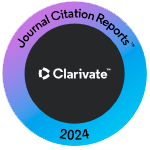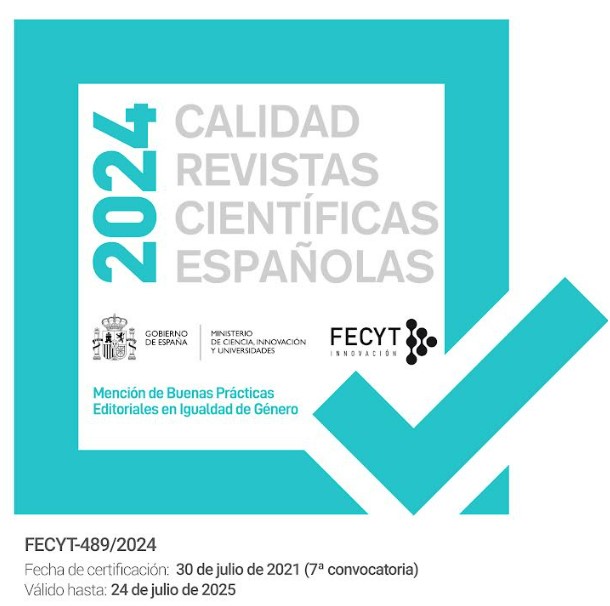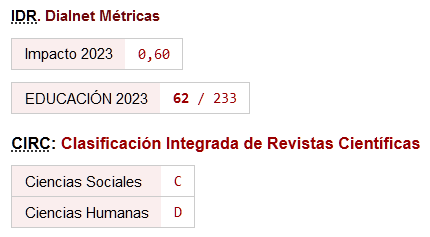Impacto de las tecnologías emergentes en el desarrollo cognitivo
el papel mediador del apoyo social digital entre estudiantes de educación superior
DOI:
https://doi.org/10.46661/ijeri.8362Palabras clave:
Tecnología Emergente, Desarrollo cognitivo, Apoyo social digital, Estudiantes de educación superiorResumen
El objetivo del presente estudio es explorar las relaciones directas e indirectas entre la tecnología emergente y el desarrollo cognitivo. Este estudio utilizó un diseño de investigación transversal, empleando un enfoque de encuesta por cuestionario para la recopilación de datos de estudiantes de educación superior. Se utilizó la escala Likert de múltiples puntos para medir la tecnología emergente, el desarrollo cognitivo y el apoyo social digital. Se recopilaron datos de 500 estudiantes, tanto hombres como mujeres, que estudiaban en universidades chinas. Se aplicó el enfoque PLS-SEM para analizar la relación estructural entre las variables dadas en este estudio de investigación. Los hallazgos del estudio indicaron que la tecnología emergente tiene una relación positiva y significativa con el desarrollo cognitivo, y que el apoyo social digital media positiva y significativamente la conexión entre la tecnología emergente y el desarrollo cognitivo entre los estudiantes de educación superior. Se concluyó que tanto la tecnología emergente como el apoyo social digital son predictores del desarrollo cognitivo de los estudiantes en el nivel de educación superior. El estudio contribuye a la literatura sobre tecnología emergente, desarrollo cognitivo y apoyo social digital en el contexto de la educación superior. Este estudio proporciona valiosas implicaciones teóricas y prácticas para profesores, psicólogos y desarrolladores de planes de estudio en el nivel de educación superior.
Descargas
Citas
Antoniou, P. E., Sidiropoulos, E. A., & Bamidis, P. D. (2017). DISCOVER-ing Beyond OpenSim; Immersive Learning for Carers of the Elderly in the VR/AR era. Immersive Learning Research Network: Third International Conference, iLRN 2017, Proceedings 3, Coimbra, Portugal, June 26–29, 2017.
Bistaman, I. N. M., Idrus, S. Z. S., & Abd Rashid, S. (2018). The use of augmented reality technology for primary school education in Perlis, Malaysia. Journal of Physics: Conference Series. https://doi.org/10.1088/1742-6596/1019/1/012064
Borthwick, A. C., Foulger, T. S., & Graziano, K. J. (2022). Championing technology infusion in teacher preparation: A framework for supporting future educators. International Society for Technology in Education.
Bosch, C., & Laubscher, D. J. (2022). Promoting Self-Directed Learning as Learning Presence through Cooperative Blended Learning. International Journal of Learning, Teaching and Educational Research, 21(9), 17-34. https://doi.org/10.26803/ijlter.21.9.2
Brown, S., Carbone, J. T., Hicks, L. M., Saini, E. K., Panisch, L. S., & Dayton, C. J. (2023). The Moderating Role of Social Support on the Cortisol Stress Response of Expectant Fathers Exposed to Adverse Childhood Experiences. Journal of Family Violence, 1-11. https://doi.org/10.1007/s10896-023-00555-1
Bygstad, B., Øvrelid, E., Ludvigsen, S., & Dæhlen, M. (2022). From dual digitalization to digital learning space: Exploring the digital transformation of higher education. Computers & Education, 182, 104463. https://doi.org/10.1016/j.compedu.2022.104463
Chen, F., Sakyi, A., & Cui, Y. (2022). Identifying Key Contextual Factors of Digital Reading Literacy Through a Machine Learning Approach. Journal of Educational Computing Research, 60(7), 1763-1795. https://doi.org/10.1177/07356331221083215
Ciccone, M., & Brayton, S. (2022). Complexities with Bridging the Digital Divide. Media Literacy for Justice: Lessons for Changing the World. Communication Graduate Student Publication Series. https://doi.org/10.4324/9781003175599-14
DeWitt, D., & Alias, N. (2023). Creative Digital Pedagogies for Student Engagement: Preparing Students for Industry 4.0. In Digitalization and Development (pp. 112-132). Routledge. https://doi.org/10.4324/9781003367093-7
Dunn, L. B., Iglewicz, A., & Moutier, C. (2008). A conceptual model of medical student well-being: promoting resilience and preventing burnout. Academic Psychiatry, 32, 44-53. https://doi.org/10.1176/appi.ap.32.1.44
Getuli, V., Capone, P., Bruttini, A., & Isaac, S. (2020). BIM-based immersive Virtual Reality for construction workspace planning: A safety-oriented approach. Automation in Construction, 114. https://doi.org/10.1016/j.autcon.2020.103160
Graesser, A. C., Sabatini, J. P., & Li, H. (2022). Educational psychology is evolving to accommodate technology, multiple disciplines, and Twenty-First-Century skills. Annual review of psychology, 73, 547-574. https://doi.org/10.1146/annurev-psych-020821-113042
Hennekens, C. H., & Buring, J. E. (1987). Epidemiology in medicine. In Epidemiology in medicine (pp. 383-383). Little Brown and Company.
Hooper, D., Coughlan, J., & Mullen, M. (2008). Evaluating model fit: a synthesis of the structural equation modelling literature. (pp.195-200). 7th European Conference on research methodology for business and management studies.
Ilić, M. P., Păun, D., Popović Šević, N., Hadžić, A., & Jianu, A. (2021). Needs and performance analysis for changes in higher education and implementation of artificial intelligence, machine learning, and extended reality. Education Sciences, 11(10), 568. https://doi.org/10.3390/educsci11100568
Javornik, A., Marder, B., Barhorst, J. B., McLean, G., Rogers, Y., Marshall, P., & Warlop, L. (2022). ‘What lies behind the filter?’Uncovering the motivations for using augmented reality (AR) face filters on social media and their effect on well-being. Computers in Human Behavior, 128, 107126. https://doi.org/10.1016/j.chb.2021.107126
Klimova, B. (2016). Computer-based cognitive training in aging. Frontiers in Aging Neuroscience, 8, 313. https://doi.org/10.3389/fnagi.2016.00313
Lepp, A., Barkley, J. E., & Karpinski, A. C. (2015). The relationship between cell phone use and academic performance in a sample of US college students. Sage Open, 5(1), https://doi.org/10.1177/2158244015573169
Liao, C.-H., & Wu, J.-Y. (2022). Deploying multimodal learning analytics models to explore the impact of digital distraction and peer learning on student performance. Computers & Education, 190. https://doi.org/10.1016/j.compedu.2022.104599
López-González, M. (2023). 69 Emotional creativity. Language and Emotion, 3 (43), 1437. https://doi.org/10.1515/9783110795486-005
Marques, B., Silva, S., Alves, J., Rocha, A., Dias, P., & Santos, B. S. (2022). Remote collaboration in maintenance contexts using augmented reality: Insights from a participatory process. International Journal on Interactive Design and Manufacturing (IJIDeM), 1-20. https://doi.org/10.1007/s12008-021-00798-6
Memon, M. A., Ramayah, T., Cheah, J.-H., Ting, H., Chuah, F., & Cham, T. H. (2021). PLS-SEM statistical programs: a review. Journal of Applied Structural Equation Modeling, 5(1), 1-14. https://doi.org/10.47263/JASEM.5(1)06
Ochonogor, W. C., & Mutula, S. M. (2020). The use of social media by medical librarians for inclusive engagement in the management of HIV/AIDS in Nigeria university teaching hospitals. In Handbook of research on digital devices for inclusivity and engagement in libraries (pp. 1-24). IGI Global. https://doi.org/10.4018/978-1-5225-9034-7.ch001
Pandey, P., & Pandey, M. M. (2021). Research methodology tools and techniques. Bridge Center.
Pellas, N., Dengel, A., & Christopoulos, A. (2020). A scoping review of immersive virtual reality in STEM education. IEEE Transactions on Learning Technologies, 13(4), 748-761. https://doi.org/10.1109/TLT.2020.3019405
Peters, M., & Romero, M. (2019). Lifelong learning ecologies in online higher education: Students' engagement in the continuum between formal and informal learning. British Journal of Educational Technology, 50(4), 1729-1743. https://doi.org/10.1111/bjet.12803
Popat, A., & Tarrant, C. (2023). Exploring adolescents’ perspectives on social media and mental health and well-being–A qualitative literature review. Clinical child psychology and psychiatry, 28(1), 323-337. https://doi.org/10.1177/13591045221092884
Sharma, P., & Devkota, G. (2019). Mental health screening questionnaire: A study on reliability and correlation with perceived stress score. Journal of Psychiatrists' Association of Nepal, 8(2), 4-8. https://doi.org/10.3126/jpan.v8i2.28017
Shokoohi-Yekta, M., Lotfi, S., Rostami, R., Motamed-Yeganeh, N., Khodabandeh-Lou, Y., & Habibnezhad, M. (2013). Brain Training by BrainWare® Safari: The Transfer Effects on the Visual Spatial Working Memory of Students with Reading Problems. AWERProcedia Information Technology & Computer Science. [Online]. 2013, 04, 1046-1052
Small, G. W., Lee, J., Kaufman, A., Jalil, J., Siddarth, P., Gaddipati, H., Moody, T. D., & Bookheimer, S. Y. (2022). Brain health consequences of digital technology use. Dialogues in clinical neuroscience, 22(2), 179-187. https://doi.org/10.31887/DCNS.2020.22.2/gsmall
Smeets, L., Gijselaers, W., Meuwissen, R., & Grohnert, T. (2022). Exploring the link between learning from error climate and professionals' engagement in social learning activities after errors. Baltic Journal of Management, 17(3), 413-428. https://doi.org/10.1108/BJM-07-2021-0278
Sosa, O., Salinas, J., & De Benito, B. (2022). Emerging technologies (ETs) in education: A systematic review of the literature published between 2006 and 2016. International Journal of Emerging Technologies in Learning, 2017, 12(5), 128-149. https://doi.org/10.3991/ijet.v12i05.6939
Torous, J., Bucci, S., Bell, I. H., Kessing, L. V., Faurholt‐Jepsen, M., Whelan, P., Carvalho, A. F., Keshavan, M., Linardon, J., & Firth, J. (2021). The growing field of digital psychiatry: current evidence and the future of apps, social media, chatbots, and virtual reality. World Psychiatry, 20(3), 318-335. https://doi.org/10.1002/wps.20883
Vaingankar, J. A., van Dam, R. M., Samari, E., Chang, S., Seow, E., Chua, Y. C., Luo, N., Verma, S., & Subramaniam, M. (2022). Social Media–Driven Routes to Positive Mental Health Among Youth: Qualitative Enquiry and Concept Mapping Study. JMIR pediatrics and parenting, 5(1), e32758. https://doi.org/10.2196/32758
Zheng, G., Song, Y., & Chen, C. (2022). Height measurement with meter wave polarimetric MIMO radar: signal model and MUSIC-like algorithm. Signal processing, 190, 108344. https://doi.org/10.1016/j.sigpro.2021.108344
Zhu, J., Yuan, H., Zhang, Q., Huang, P.-H., Wang, Y., Duan, S., Lei, M., Lim, E. G., & Song, P. (2022). The impact of short videos on student performance in an online-flipped college engineering course. Humanities and Social Sciences Communications, 9(1), 1-10. https://doi.org/10.1057/s41599-022-01355-6
Descargas
Publicado
Cómo citar
Número
Sección
Licencia
Derechos de autor 2023 Aashiq, Irum Zeb, Yan Zhang, Tahir

Esta obra está bajo una licencia internacional Creative Commons Atribución-NoComercial-SinDerivadas 4.0.












